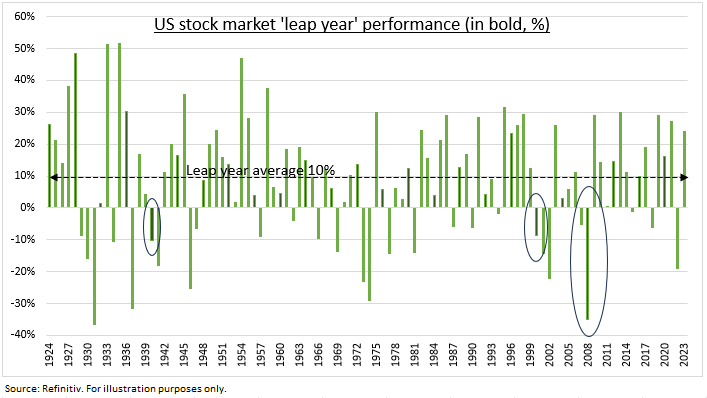LEAP: February 29th is a rare ‘leap day’. This is the extra day we receive once every four years to realign with the solar calendar. It existed in the Roman Julian calendar and was refined in the 1582 Gregorian calendar we still use today. It’s a minor but real disruption for companies and markets, from earnings reporting through to calculating bond interest. It has typically been a poor day for markets. Though does make for a better year, maybe as it also aligns with US presidential elections. And this ‘leap day’ is a reminder that just four years ago we were starting to deal with the first covid lockdowns, with stock markets plunging, and authorities intervening.
IMPACTS: The extra day will have a number of small impacts for companies and markets to be aware of and considering. 1) First quarter company earnings will see an extra sales day, boosting revenues by c. 1%. These reports start on April 12th, with JP Morgan (JPM). Walmart (NYSE:WMT), for example, has already incorporated into its projected sales growth. 2) Comparable figures, like same store sales growth, may need to be adjusted. 3) HR will need to change payroll, with increased expenses for non-salaried staff. Relevant across industries from retail to construction. 4) Accounting will need to tweak depreciation and amortisation calculations. 5) Bondholders will see an extra day of interest, and many bonds adjust their yield-to-maturity.
MARKET: Leap days only happen every four years. And the stock market is not open on every leap day. Since the S&P 500 index was created in the 1950’s we have seen thirteen leap days with the market open. It has only risen on five of those. Or a lower than average 38% of the time. The better news is that leap years have much better performance. Maybe because it coincides with the US election cycle. In the past century, US stocks have risen 88% of the time in a leap year. Only falling in three: in 1940, 2000 tech bust, and 2008 global financial crisis (see chart). 
- English (USA)
- English (India)
- English (Canada)
- English (Australia)
- English (South Africa)
- English (Philippines)
- English (Nigeria)
- Deutsch
- Español (España)
- Español (México)
- Français
- Italiano
- Nederlands
- Português (Portugal)
- Polski
- Português (Brasil)
- Русский
- Türkçe
- العربية
- Ελληνικά
- Svenska
- Suomi
- עברית
- 日本語
- 한국어
- 简体中文
- 繁體中文
- Bahasa Indonesia
- Bahasa Melayu
- ไทย
- Tiếng Việt
- हिंदी
Leap days matter, a little
Latest comments
Loading next article…
Install Our App
Risk Disclosure: Trading in financial instruments and/or cryptocurrencies involves high risks including the risk of losing some, or all, of your investment amount, and may not be suitable for all investors. Prices of cryptocurrencies are extremely volatile and may be affected by external factors such as financial, regulatory or political events. Trading on margin increases the financial risks.
Before deciding to trade in financial instrument or cryptocurrencies you should be fully informed of the risks and costs associated with trading the financial markets, carefully consider your investment objectives, level of experience, and risk appetite, and seek professional advice where needed.
Fusion Media would like to remind you that the data contained in this website is not necessarily real-time nor accurate. The data and prices on the website are not necessarily provided by any market or exchange, but may be provided by market makers, and so prices may not be accurate and may differ from the actual price at any given market, meaning prices are indicative and not appropriate for trading purposes. Fusion Media and any provider of the data contained in this website will not accept liability for any loss or damage as a result of your trading, or your reliance on the information contained within this website.
It is prohibited to use, store, reproduce, display, modify, transmit or distribute the data contained in this website without the explicit prior written permission of Fusion Media and/or the data provider. All intellectual property rights are reserved by the providers and/or the exchange providing the data contained in this website.
Fusion Media may be compensated by the advertisers that appear on the website, based on your interaction with the advertisements or advertisers.
Before deciding to trade in financial instrument or cryptocurrencies you should be fully informed of the risks and costs associated with trading the financial markets, carefully consider your investment objectives, level of experience, and risk appetite, and seek professional advice where needed.
Fusion Media would like to remind you that the data contained in this website is not necessarily real-time nor accurate. The data and prices on the website are not necessarily provided by any market or exchange, but may be provided by market makers, and so prices may not be accurate and may differ from the actual price at any given market, meaning prices are indicative and not appropriate for trading purposes. Fusion Media and any provider of the data contained in this website will not accept liability for any loss or damage as a result of your trading, or your reliance on the information contained within this website.
It is prohibited to use, store, reproduce, display, modify, transmit or distribute the data contained in this website without the explicit prior written permission of Fusion Media and/or the data provider. All intellectual property rights are reserved by the providers and/or the exchange providing the data contained in this website.
Fusion Media may be compensated by the advertisers that appear on the website, based on your interaction with the advertisements or advertisers.
© 2007-2024 - Fusion Media Limited. All Rights Reserved.
